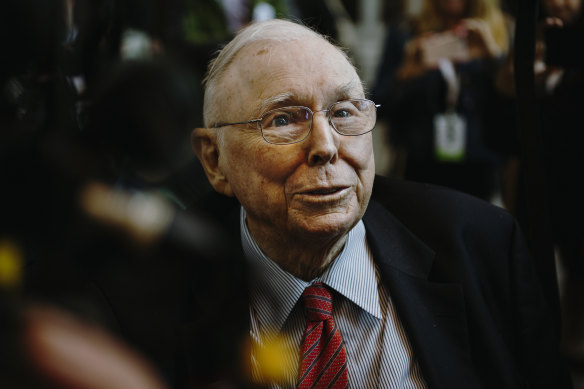Save articles for later
Add articles to your saved list and come back to them any time.
So, First Republic Bank has been seized and its assets sold to JPMorgan Chase & Co. The US banking crisis seems over, but is it?
As expected, the US Federal Deposit Insurance Corporation took control of the Californian-based bank on Monday and, after a rapid auction process, sold its $US93.5 billion ($141 billion) of deposits and its $US173 billion loan portfolio to JPMorgan, the “highest” bidder.
JPMorgan chief Jamie Dimon is uncertain about what the future holds.Credit: Bloomberg
The FDIC will foot a $US13 billion bill for the bailout of depositors – it could end up being more – and lent JPMorgan $US50 billion to rescue First Republic’s depositors and hopefully end what has been a series of bank failures that threatened the stability of the country’s regional and local banking sector.
The $US13 billion is the FDIC’s estimate of the cost to its insurance fund, which is financed by contributions from US banks. With the previous failures of the Silicon Valley and Signature banks the total cost, so far, of the bank failures is about $US35 billion.
JPMorgan’s chief executive Jamie Dimon, who was also in that position when the bank acquired Bear Stearns and Washington Mutual during the financial crisis a decade-and-a-half ago, declared the latest panic had ended with his acquisition of First Republic.
It wasn’t, however, an unqualified declaration.
“No crystal ball is perfect but, yes, I think the banking system is very stable,” he told analysts on a conference call to discuss the acquisition. “Down the road,” he said (without elaborating), was a “whole different issue.”
The sudden panic that enveloped the three US banks and overwhelmed Credit Suisse was a liquidity-driven crisis, sparked by the impact of the rapid rises in interest rates on balance sheet with large holdings of low-yielding fixed rate bonds and mortgages. As interest rates rose, so did the amounts of unrealised losses on those assets if their value were marked to market.
As runs on the banks started, fuelled by social media – First Republic lost $US100 billion of deposits in a couple of weeks and Silicon Valley was looking at $US100 billion in a day when its doors closed – the need to raise cash to meet the depositors’ demands meant those “paper” losses would have to be crystallised.
In Australia, this kind of liquidity crisis couldn’t have occurred. Not only do Australian banks hold more capital and higher-quality liquid assets than their international peers but this is the only jurisdiction where banks have to increase their capital when rising interest rates generate unrealised losses on their holdings of securities and mortgages.
Most banking crises start with loan losses that create a questionmark over a bank’s solvency that subsequently generates a “run” and a liquidity event. That’s not quite what happened in the US, where the catalyst for the failures was the sudden and impossible demands on the banks’ ability to repay depositors.
There’s a “chicken and egg” element to the relationship between liquidity and solvency because of the structural mismatch in all banks between their funding, which is relatively short term, and their loans, which are much longer term. A sustained run inevitably leads to insolvency because of the firesales of assets needed to meet the redemption of deposits.
“Down the road,” US banks, and banks elsewhere, may face a more conventional solvency issue from the rate and extent of the interest rate rises over the past year or so, increases that may continue – and continue to devalue securities and loan portfolios written when rates were closer to zero – before they peak and retreat.
Commercial property is the most obvious vulnerability for banks in a rising interest rates environment, a vulnerability that has been exacerbated by the impact of the pandemic on companies’ space requirements now that significant proportions of their workforces work from home on any given day.
If you were looking for real economy effects of the Federal Reserve Board’s monetary policies over the past year or so, the property markets would be among the most obviously threatened asset classes.
Warren Buffett’s offsider, Charlie Munger, said in an interview with the Financial Times that US banks were full of bad loans.
“We have a lot of troubled office buildings, a lot of troubled shopping centres, a lot of troubled other properties. There’s a lot of agony out there.”
Given that it is the regional and local banks in the US that do most of the commercial property lending, it is the prospect of loan losses rising sharply from that spending that might represent the next phase of the challenges the sector and its regulators face.
A contraction in lending by banks unsettled and made more cautious by the failure of three of their peers would make life even more difficult for the property sector and businesses more generally and rebound on the banks themselves.
Warren Buffett’s offsider, Charlie Munger is less than optimistic about the future.Credit: Getty
A cycle of rising unemployment, falling property prices (residential and commercial) and increased loan losses for banks is what would normally be expected from the monetary policies being employed in most advanced economies. For the US, that may be the next phase of the banking crisis. Elsewhere, it might be the first phase.
These moments are when banks and their regulators are stress-tested. In the US, a lack of prudence by bank executives and their boards as they chased growth lax supervision and the rolling back by the Trump administration of some post-2008 banking reforms all contributed to the recent bank failures.
In Australia, by contrast, the Australian Prudential Regulation Authority had already adopted a conservative version of the global banking reforms implemented after the global financial crisis and then tightened them substantially after the 2014 financial system inquiry led by David Murray and again after the banking royal commission.
Risks in banking, even if the underlying causes of collapse inevitably involve liquidity and solvency, always evolve. The speed at which the US runs developed because of social media, for instance, took everyone by surprise.
There will be a lot of learnings from the US experience, particularly around the effectiveness of deposit insurance schemes. It was the uninsured deposits, above the $US250,000 insurance cap, that undermined the three banks. Should all deposits be insured? Should some economically sensitive deposits, like corporate cash earmarked to pay their workers, be insured? Should depositors above the caps pay their own premiums for protection?
US banking regulation and regulators have been proven inadequate for the task. Inevitably there will be a Democrat-led push to tighten the regulation of smaller banks that the Trump administration loosened. Other regulators will run their own self-assessments in the light of the US experience.
Risks in banking, even if the underlying causes of collapse inevitably involve liquidity and solvency, always evolve. The speed at which the US runs developed because of social media, for instance, took everyone by surprise.
The potential for aftershocks from the increases in interest rates and the withdrawals of central bank liquidity from financial systems, however, should have been better recognised and regulators in the US and Credit Suisse’s Swiss overseers should have been more alert to them.
Now that they, their central banks and their regulatory peers elsewhere, have been alerted it will be revealing, and potentially critical for their economies and financial stability, to see how quickly they respond.
The Business Briefing newsletter delivers major stories, exclusive coverage and expert opinion. Sign up to get it every weekday morning.
Most Viewed in Business
From our partners
Source: Read Full Article


